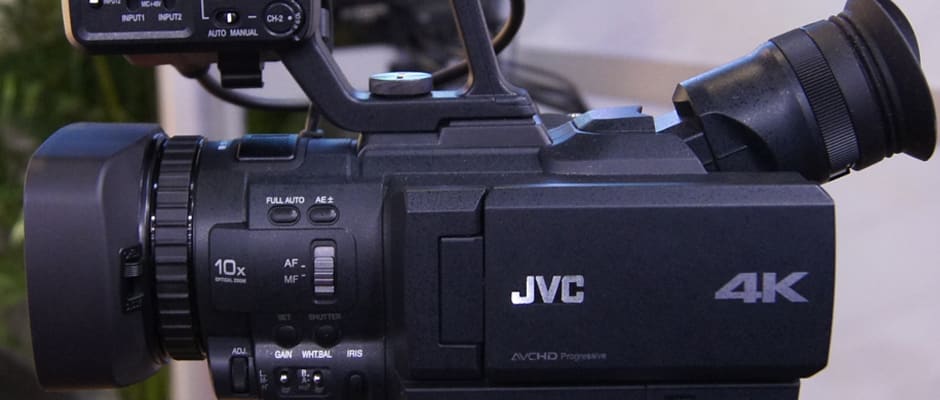Pros
Cons
Introduction
In order to make its 4K camcorder happen, JVC built upon its powerful Falconbrid processor that the company introduced on its Double Full HD 3D camcorder last year at CES. The camcorder also makes use of four SD memory card slots in order to record four individual streams of video content that, together, create a unified 4K video image. It's certainly an unusual process that is more power-intensive and complex than anything we've seen in the industry for quite some time. But JVC is banking on the idea that 4K video is just a few years away from taking off, otherwise the GY-HMQ10 will end up as a novelty camcorder with little use to anyone in the industry.
The JVC GY-HMQ10 will retail for around $4995, with the first deliveries scheduled for March, 2012.
Lens & Imaging System
{{section_header}}{{section.name}}{{/section_header}}

The JVC GY-HMQ10's sensor is impressive, but it isn't really any different than the image sensors used by JVC in its flagship consumer camcorders. The 1/2.3-inch CMOS with 8.3 million pixels does allow for 4K recording, but it's really the camcorder's new Falconbrid processor that makes the 4K video image possible. Many camcorder manufacturers use a 1/2-inch size sensor with this many pixels, but the HMXQ10 is one of the few on the market that can record 4K.
The large f/2.8 lens on the front of the HMQ10 is equipped with a generous lens hood and a manual lens cover switch on the side of the camcorder.
Front
{{section_header}}{{section.name}}{{/section_header}}
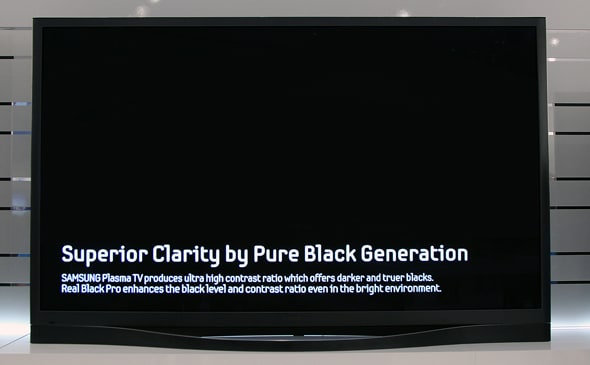
Right
{{section_header}}{{section.name}}{{/section_header}}
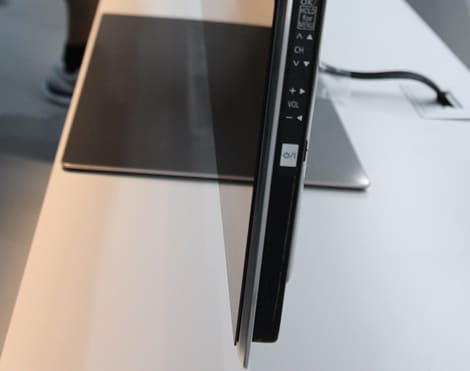
Back
{{section_header}}{{section.name}}{{/section_header}}
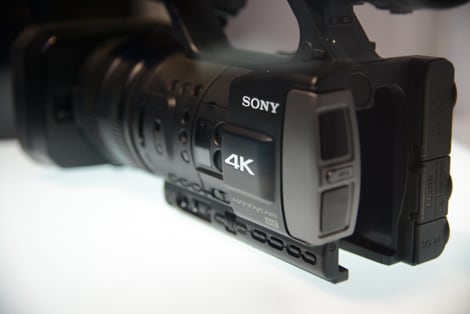
Left
{{section_header}}{{section.name}}{{/section_header}}
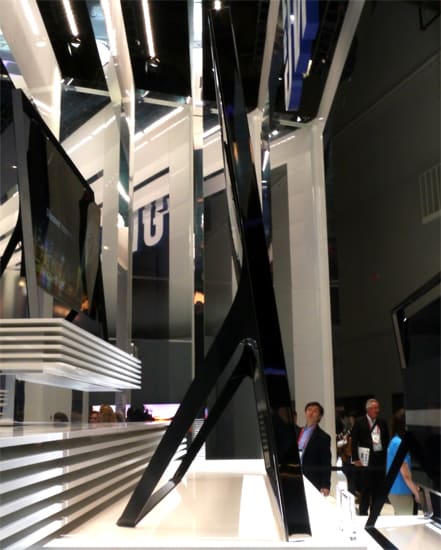
Top
{{section_header}}{{section.name}}{{/section_header}}

Compression
{{section_header}}{{section.name}}{{/section_header}}
Compression is usually one of the more boring sections of our camcorder reviews, but with the GY-HMQ10 compression is the big story. As you most likely have already heard (or garnered through reading bits of this review), the HMQ10 can record a 4K2K image—yes, that's a video image that is four times the resolution of traditional Full HD (1920 x 1080). The HMQ10 is not the first camcorder with this capability, as the Red Cinema Company has released a couple of 4K camcorders in the past.
But the JVC GY-HMQ10 is the first truly handheld 4K camcorder made by a major manufacturer, and it's all made possible by JVC's Falconbrid processor. This processor was first introduced in JVC's 3D camcorder, the GS-TD1, and it makes sense that JVC would be able to tweak it to handle 4K2K video recording. Double Full HD 3D, as JVC called it, already requires capturing two Full HD images, so the powerful processor needed in the TD1 was already halfway to handling 4K.
Read more about the advantages and disadvantages of different compression types.
The way the 4K recording works is by capture four different video streams (or quadrants), each recorded to a separate SD card loaded in the HMQ10. These individual streams record at a max bitrate of 36Mbps, which totals to 144Mbps when you put them all together. Multiple processors are used in the camcorder in the effort to convert the footage to the MPEG-4 format. This footage is not AVCHD compliant, as there are no AVCHD standards for 4K recording.
In the end, the 4K2K resolution recorded by the camcorder comes to a 3840 x 2160 video image, which can then be output to a 4K2K display (using four separate HDMI connections). Or you can transfer the footage to a computer using JVC's provided software (see the editing section below).
For recording 4K2K video, the HMQ10 offers 60p, 50p, or 24p frame rates. There are also five regular Full HD record modes on the camcorder, one of which records using a 60p frame rate and the rest using a 60i frame rate. JVC explains the 4K2K recording process rather succinctly on its website, so you can read more about the camcorder here.
Media
{{section_header}}{{section.name}}{{/section_header}}
Yes, there are actually four memory card slots on the JVC GY-HMQ10, and, yes, you must use all four at the same time in order to record a 4K2K video image. If you're just shooting regular HD video, you can load just one card into the camcorder, but you must have four memory cards inserted to record 4K video.
Read more about the advantages and disadvantages of different media types.

We can't emphasize this fact enough, because we're sure it is something most consumers will overlook initially. JVC claims the camcorder can record a full two hours of 4K2K video, which may sound impressive until you realize that's with four 32GB SDHC cards inserted in the camcorder at once! So, just to shoot 4K video you need to shell out quite a bit of cash for memory cards before you can even get started. You can use higher-capacity SDXC cards with the camcorder as well, but SDXC cards are still very expensive.
Editing
{{section_header}}{{section.name}}{{/section_header}}
Now that you've shot your 4K2K video, you'll probably want to edit the content to make a finished product. Luckily, JVC provide a file utility with the HMQ10 that is used to combine the four individual recording streams into a single, editable file. You'll still need a 4K-compatible editing program, though, and there isn't much software on the market that can handle that. We're also unsure if the provided file utility works with Macs.
Auto Mode
{{section_header}}{{section.name}}{{/section_header}}
The GY-HMQ10 is a camcorder for the serious video enthusiast or professional videographer, so auto controls aren't really its thing. But if you do have the urge to let the camcorder run the show, the HMQ10 is equipped with a Full Auto button that puts the model under entirely automated control. This dedicated auto mode is very similar to the auto mode we've seen on JVC's consumer camcorder line, although the HMQ10 has some extra "advanced" auto controls like AE shift and the like.

Zoom
Focus
{{section_header}}{{section.name}}{{/section_header}}
The camcorder is equipped with a large, fancy lens ring that wraps around the entirety of the lens barrel. We didn't get to play around with the focus ring for a huge amount of time while we were on the show floor at CES, but in our few minutes with the camcorder we found focus adjustments worked very well—much like we've experienced before on the GY-HM150 JVC camcorder. For people who really want to fine tune the focus on the HMQ10, the camcorder offers JVC's patented focus assist features that include a variety of peaking settings.
Aperture
{{section_header}}{{section.name}}{{/section_header}}
While we do love the large lens ring on the GY-HMQ10, we have problems with the tiny little dial near the front of the camcorder that's used to adjust aperture and shutter speed. The dial is flimsy, small, and doesn't make for precise adjustment of manual controls. We wish JVC had included a second lens ring for these functions instead of the tiny adjustment dial.
Shutter Speed
{{section_header}}{{section.name}}{{/section_header}}
Shutter speed, like aperture, can be set manually on the camcorder using the small dial on the left side of the HMQ10. There are also dedicated buttons for switching between automatic and manual control for both shutter speed and aperture (iris).
White Balance
{{section_header}}{{section.name}}{{/section_header}}
Far better than the small adjustment dial are the two dedicated switches on the left side of the camcorder that offer quick changes to white balance and gain. These switches let you choose up to three preset white balance options, so you can move between color temperatures with blazing speed. For example, one switch can be set to indoor lighting and another can be set to bright daylight—and if you're moving repeatedly between the two, all you need to do is flick a switch to change the white balance. No need to go into the menu system at all.
Gain
{{section_header}}{{section.name}}{{/section_header}}
The gain switches may be even more effective than the white balance ones, because they let you adjust the gain boost on the fly (which is probably something you'll want to do more than switch around the white balance). The switch has three settings, labeled low, medium, and high, and you can set the values for each in the camcorder's menu system.
Color & Image Controls
{{section_header}}{{section.name}}{{/section_header}}
The GY-HMQ10 is a professional camcorder at its core, so it's no surprise that there are tons of special color and image controls found in the menu system. We didn't get to play around with most of the controls, but sifting through the camcorder's menu we saw options for manually adjusting gamma, color matrix, and pixel shifting. Not to mention pro-level assistance features like peaking and zebra patterns.
Also, JVC showed off the HMQ10's time-lapse recording function at CES. This is a feature JVC includes on many of its camcorders—both professional and the consumer-level Everio models—but the HMQ10 is the only one that can record time-lapse video in a 4K2K resolution. The amount of detail in these time-lapse videos was impressive to say the least.
Ease of Use
{{section_header}}{{section.name}}{{/section_header}}
Other than its 4K2K recording capability, the GY-HMQ10 shares many of the same features and design elements as the JVC GY-HM150. It also looks similar to JVC's first iteration of its "compact" professional camcorder line, the GY-HM100 (and you can read our review of that model here, if you'd like).
The HMQ10 is definitely not the most challenging pro camcorder we've ever seen. The way the controls are organized and displayed makes the camcorder feel more like a bridge model between consumer and professional (prosumer?), so if you feel comfortable being someone in between those two categories, then the HMQ10 will definitely be easy enough for you to handle.
Handling
{{section_header}}{{section.name}}{{/section_header}}
The compact design does give the HMQ10 a somewhat cramped feel, but we like most of the buttons, switches, an design elements on the camcorder. The only thing we're really on record as being strongly disappointed with is the camcorder's tiny adjustment dial that is used to set aperture and shutter speed control (just give us a second lens ring!). Other than that cop-out, the GY-HMQ10 offers a good user experience and settings can be adjusted on the fly with ease. Yes, the camcorder does make use of a touchscreen interface, which may be a turn-off to some pros, but the screen really isn't that bad when you get used to it.
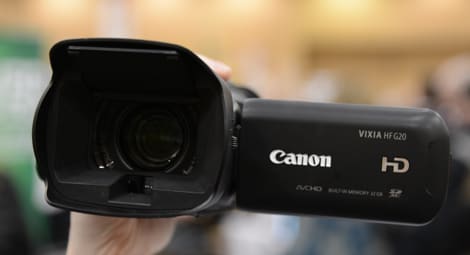
There are three assignable user buttons on the camcorder, as well as a few customizable dials and switches. All of this makes the HMQ10 rather easy to use on the fly. The menu system is somewhat annoying to navigate, especially if you're not a fan of touchscreens, but it wasn't something that bothered us too much. There are enough dedicated buttons and switches on the HMQ10 that going into the menu system can be avoided most of the time.


Stabilization
{{section_header}}{{section.name}}{{/section_header}}
The camcorder features built-in optical image stabilization, just like its GY-HM150 and GY-HM100 predecessors. Since all of the GY-HMQ10's we worked with on the show floor were strapped to tripods, we didn't get a chance to see the stabilization in action.
Portability
{{section_header}}{{section.name}}{{/section_header}}
How "portable" you deem the HMQ10 to be really depends on what you're comparing the camcorder to. As an all-in-one 4K recording device, the HMQ10 is certainly more portable than the Red One (the other 4K camcorder on the market). It's also smaller and more compact than most professional camcorders. But, when you consider the 4 SD memory card requirement to shoot 4K footage with the HMQ10, it's easy to see where the camcorder comes short in terms of portability. If you're going out for a long 4K shoot, you're gonna need to pack dozens of memory cards to get your footage—and that's not good for portability.
LCD & Viewfinder
{{section_header}}{{section.name}}{{/section_header}}
The 3.5-inch touchscreen with a 920k pixel display doesn't even come close to having a 4K resolution. Of course, it would be asking a lot from JVC to include a 4K LCD on its camcorder, especially since there are only a handful of 4K monitors that are even on the market. The screen has a glossy coating, which helps it attract plenty of greasy fingerprints, although that's kind of hard to avoid with touchscreens.
You can avoid the screen altogether (except when you have to access the menu system) by using the electronic viewfinder on the back of the camcorder instead. The viewfinder extends and pivots, has a decent eye cup, and carries a 260k resolution.



Playback
{{section_header}}{{section.name}}{{/section_header}}
Once you've got yourself a 4K camcorder and you've shot yourself some glorious 4K footage, the next challenge is trying to figure out how to playback that content at a 4K2K resolution. The reality is it's going to be incredibly difficult. 4K televisions are few and far between, and even this year at CES—where 4K was one of the most popular buzzwords being thrown around on the show floor—only a handful of 4K screens were on display. We reviewed a few of them, like this 20-inch screen from Panasonic, but others were prototypes that weren't ready to be scrutinized by the press.
JVC punts on this issue by saying 4K monitors and televisions will become more and more common every year, and they're probably right on that front. But for now, getting a 4K television is extremely difficult and extremely expensive. If you do have access to one, however, you'll need to connect the HMQ10's four (yes, four) HDMI outputs to the screen at once. Each HDMI output directs a separate video stream from the four individual streams captured by the camcorder that enable 4K recording. It's unclear at this point what 4K televisions will even work with this connection system, although we saw JVC using Toshiba TVs to show off the HMQ10's 4K capability at CES.
If you don't have a 4K television on hand, you can hook the camcorder up to a regular HDTV and the HMQ10 will automatically down-convert the footage. It'll probably look pretty good, but it won't be a 4K2K resolution. There is a playback function on the camcorder that allows you to look at a chunk of Full HD video taken from a larger 4K video clip. JVC calls this HD Trimming, and it's essentially a digital zoom function as you're taking a small crop from the full recorded video. This "small crop" just happens to be a Full HD image.
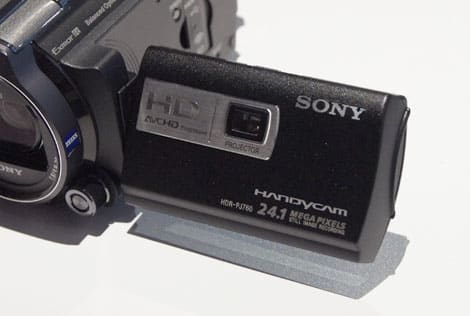
The built-in projector is a cool feature, despite its limited usefulness.
Audio Features
{{section_header}}{{section.name}}{{/section_header}}
One of the benefits of a prosumer camcorder is the presence of professional audio recording capability. the GY-HMQ10 has two XLR inputs and a boatload of manual audio controls. When shooting 4K video, the camcorder records audio using the AAC format, while regular HD footage is tied to Dolby Digital AC3 audio encoding. There's an audio level display, phantom power for each XLR input, and basically everything you need to capture professional-grade audio. If you don't want to hook up an external mic to the camcorder, the on-board built-in stereo mic can suffice on-the-fly recording.

Connectivity
Conclusion
The GY-HMQ10 isn't the first 4K camcorder to hit the market, but JVC describes it as the world's first "handheld 4K camcorder." It's also the first 4K model to be released by a major camcorder manufacturer, which means the competition is definitely watching. With its $4995 price tag, the HMQ10 is aggressively priced for the prosumer market, especially since the camcorder is outfitted with professional-grade manual controls and features.
But the thought of recording and working with 4K video at this point is somewhat outrageous. Sure, the camcorder may not be wildly overpriced, but think about everything else you'll need to purchase just to shoot, view, and edit the 4K video content. Televisions that can display 4K2K resolutions are extremely rare and are bound to cost a lot of money, at least at first, and it's not even a certainty that all future 4K2K screens will be compatible with the GY-HMQ10's 4K video output system.
You also have to consider the costs of multiple SD cards, as the HMQ10 requires four of them to be used at once to record 4K video. And there's the fact that editing solutions for 4K video are still in their infancy, especially in a time when editors are still trying to work out the kinks of 3D and progressive AVCHD content.
In its defense, the GY-HMQ10 looks to be a pretty good Full HD camcorder even without the 4K recording options. So, you could get the HMQ10, use it to shoot regular 1080p HD for now, and hang onto it until 4K becomes more mainstream. Maybe that's the plan JVC is going for, and we're not entirely opposed. If you can make a camcorder with a 4K shooting option, why not do it? It can't hurt, right?
Photo Gallery
{{photo_gallery "FI Lens Image", "FI Front Image", "FI Right Image", "FI Back Image", "FI Left Image", "FI Left Open Image", "FI Top Image", "FI Bottom Image", "FI Media Image", "FI Easy Mode Image", "FI Zoom Image", "FI Zoom Image 2", "FI 3D Lens Image", "FI 3D Lens Image 2", "FI 3D Physical Controls", "FI 3D Physical Controls 2", "FI Handling Image", "FI Handling Image 2", "FI Handling Image 3", "FI Battery Image", "FI LCD Image", "FI Viewfinder Image", "FI Viewfinder Image 2", "FI Playback Image", "FI Mic Image", "FI Flash Image", "FI Photo Mode Image", "FI Ports Image 1", "FI Ports Image 2", "FI Ports Image 3", "FI Ports Image 4", "FI Ports Image 5", "FI Ports Image 6"}}
Specs
{{manufacturer_specs_table}}
Meet the tester
Jeremy is the video expert of our imaging team and Reviewed.com's head of video production. Originally from Pennsylvania and upstate NY, he graduated from Bard college with a degree in film and electronic media. He has been living and working in New England since 2005.
Checking our work.
Our team is here to help you buy the best stuff and love what you own. Our writers, editors, and experts obsess over the products we cover to make sure you're confident and satisfied. Have a different opinion about something we recommend? Email us and we'll compare notes.
Shoot us an email